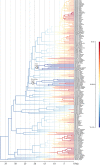Diversification rates and phenotypic evolution in venomous snakes (Elapidae)
- PMID: 26909162
- PMCID: PMC4736917
- DOI: 10.1098/rsos.150277
Diversification rates and phenotypic evolution in venomous snakes (Elapidae)
Abstract
The relationship between rates of diversification and of body size change (a common proxy for phenotypic evolution) was investigated across Elapidae, the largest radiation of highly venomous snakes. Time-calibrated phylogenetic trees for 175 species of elapids (more than 50% of known taxa) were constructed using seven mitochondrial and nuclear genes. Analyses using these trees revealed no evidence for a link between speciation rates and changes in body size. Two clades (Hydrophis, Micrurus) show anomalously high rates of diversification within Elapidae, yet exhibit rates of body size evolution almost identical to the general elapid 'background' rate. Although correlations between speciation rates and rates of body size change exist in certain groups (e.g. ray-finned fishes, passerine birds), the two processes appear to be uncoupled in elapid snakes. There is also no detectable shift in diversification dynamics associated with the colonization of Australasia, which is surprising given that elapids appear to be the first clade of venomous snakes to reach the continent.
Keywords: body size; macroevolution; phylogenetics; reptiles; speciation rates.
Figures


References
-
- Ricklefs RE. 2004. Cladogenesis and morphological diversification in passerine birds. Nature 430, 338–341. (doi:10.1038/nature02700) - DOI - PubMed
-
- Rabosky DL, Santini F, Eastman J, Smith SA, Sidlauskas B, Chang J, Alfaro ME. 2013. Rates of speciation and morphological evolution are correlated across the largest vertebrate radiation. Nat. Commun. 4, 1958 (doi:10.1038/ncomms2958) - DOI - PubMed
-
- Venditti C, Meade A, Pagel M. 2011. Multiple routes to mammalian diversity. Nature 479, 393–396. (doi:10.1038/nature10516) - DOI - PubMed
-
- Burbrink FT, Chen X, Myers EA, Brandley MC, Pyron RA. 2012. Evidence for determinism in species diversification and contingency in phenotypic evolution during adaptive radiation. Proc. R. Soc. B 279, 4817–4826. (doi:10.1098/rspb.2012.1669) - DOI - PMC - PubMed
-
- Adams DC, Berns CM, Kozak KH, Wiens JJ. 2009. Are rates of species diversification correlated with rates of morphological evolution? Proc. R. Soc. B 276, 2729–2738. (doi:10.1098/rspb.2009.0543) - DOI - PMC - PubMed
LinkOut - more resources
Full Text Sources
Other Literature Sources

